 |
||||
Implications of Cercopagis and Bythotrephes to Alewife Recruitment and Stability of the Lake Michigan Pelagic Food Web
Principle Investigator: Henry Vanderploeg
Co-principal Investigators:
W. Charles Kerfoot, Michigan Technological University
(MTU web site)
Chuck Madenjian, USGS Great Lakes Science Center (GLSC
web site)
Doran Mason, GLERL
Bob O'Gorman, USGS Great Lakes Science Center
Radka Pichlová, University of Oslo (UIO
web site)
Steve Pothoven, GLERL
Edward Rutherford, UM School of Natural Resources and Environment (SNRE
web site)
Jeff Schaeffer, USGS Great Lakes Science Center
David Warner, USGS Great Lakes Science Center
Project Overview
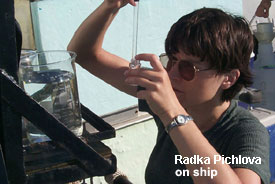 We
propose to develop a general model from experimental observations of prey
selection and feeding for the invading predatory cercopagid cladocerans
Cercopagis pengoi and Bythotrephes longimanus (Fig.
1) that will be useful for predicting predatory impact of these cercopagids.
We will combine this information along with field observations of population
dynamics, production and spatial distribution of zooplankton and fishes
collected in this and related projects to describe and understand invasion
dynamics of Cercopagis and determine if these cercopagids have
disrupted the Lake Michigan food web. We hypothesize that alewife predation
on Bythotrephes, a competitor and predator of Cercopagis
(this study), has allowed Cercopagis to invade nearshore waters
of the spatially complex Lake Michigan. We are also examining whether
both these cercopagids have created a bottleneck for recruitment of young
of year alewife and other fishes. In a new approach, we are exploring
the use of sequential sediment traps to define population dynamics of
cercopagids, including proportion killed by fish predation.
We
propose to develop a general model from experimental observations of prey
selection and feeding for the invading predatory cercopagid cladocerans
Cercopagis pengoi and Bythotrephes longimanus (Fig.
1) that will be useful for predicting predatory impact of these cercopagids.
We will combine this information along with field observations of population
dynamics, production and spatial distribution of zooplankton and fishes
collected in this and related projects to describe and understand invasion
dynamics of Cercopagis and determine if these cercopagids have
disrupted the Lake Michigan food web. We hypothesize that alewife predation
on Bythotrephes, a competitor and predator of Cercopagis
(this study), has allowed Cercopagis to invade nearshore waters
of the spatially complex Lake Michigan. We are also examining whether
both these cercopagids have created a bottleneck for recruitment of young
of year alewife and other fishes. In a new approach, we are exploring
the use of sequential sediment traps to define population dynamics of
cercopagids, including proportion killed by fish predation.
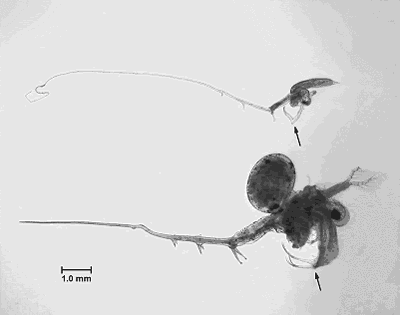
Figure 1. Contrast between morphology and size of Cercopagis pengoi (upper) and Bythotrephes cederstroemi (lower) collected in Lake Michigan collected July-August, 2000, in waters of 45-m depth off Muskegon Michigan. Arrows point to the first thoracopods, which putatively would be important for grasping and holding large prey.
Background
Beginning in 2000, Radka Pichlová and Hank Vanderploeg started experimental work on food web interactions in Lake Michigan. Their focus has been on two cercopagids; the Ponto-Caspian predatory cladoceran Cercopagis, which invaded Lake Michigan in 1999, and competition and predatory interactions with Bythotrephes, a larger predatory cercopagid of Palaearctic origin that invaded Lake Michigan in 1985 (Fig. 1). It is of great importance to invasion theory how Cercopagis, similar to the already established Bythotrephes, found a "niche" in Lake Michigan. The major concern about both species of cercopagids is that they may compete with small fishes such as larval and young of year (YOY) alewife and perch for zooplankton (Fig. 2). The tail spine of both cercopagids foils predation by small fishes; however, cercopagids may be preferred prey of large fishes (Fig. 2). Because cercopagids have high reproductive output, high feeding rates and can prey on cladocerans large relative to their body size, they could be serious competitors with larval and small fishes.
To examine potential food-web impacts and interactions, Pichlova conducted feeding experiments in large bottles and small enclosures to determine prey selection and feeding rates of Cercopagis on different zooplankton, predatory interactions among Bythotrephes, Cercopagis, and Leptodora (a native predatory cladoceran). Results show that Cercopagis prefers smaller prey than Bythotrephes. For example, she showed Cercopagis would eat small zooplankton such as copepod nauplii, Bosmina, and zebra mussel larvae. Although much has been done, much more work on prey selectivity and functional response to prey concentration remains for both species. Preliminary insights into feeding mechanisms were obtained by direct observation with video: Cercopagis are slower than Bythotrephes and thus may be less adept at capturing quick, agile prey like copepods.
In 2001 and 2002 Doran Mason and colleagues (the larval fish team) carried out a field project of extensive sampling of zooplankton and larval fishes May through October in Muskegon Lake and in nearshore and offshore regions of Lake Michigan in support of the research grant "Dynamics of Alewife Recruitment Variability in Lake Michigan" (PI's: Edward Rutherford, U. of M.; Doran Mason, GLERL; Charles Madenjian, USGS-Great Lakes Science Center; and William Patterson, Syracuse U.). The larval fish team is examining the role of drowned river mouths such as Muskegon Lake. in comparison with nearshore and offshore Lake Michigan for supporting alewife recruitment. In theory, the warm, nutrient- and zooplankton-rich drowned river mouths should support enhanced growth and survival of larval and YOY alewives relative to Lake Michigan proper.
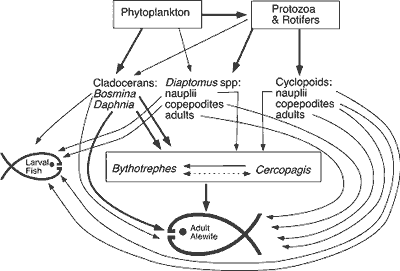
Figure 2. Bythotrephes cederstroemi and Cercopagis pengoi in the epilimnetic food webs of Great Lakes and their connection to important epilimnetic forage fishes, which would be alewives in Lakes Michigan. Thick arrows indicate high selectivities of the consumer and thin arrows indicate low selectivities. We anticipate that Cercopagis would prefer smaller cladocerans (Bosmina) than would Bythotrephes and that Cercopagis could be prey of Bythotrephes. The dotted line with two arrowheads on it implies potential competitive interactions because of similar diet preferences.
To understand invasion dynamics and document impacts of Cercopagis on alewife recruitment the zooplankton team (Vanderploeg, Cavaletto, Pichlova, and intern) is examining zooplankton samples collected summer and fall of 2001 and March - December 2002 and 2003 (biweekly during summer, monthly at other times) from station C, the deepest site in Muskegon Lake, along with samples from M110, M45, M15, the stations on 110-m, 45-m, and 15-m contours of the onshore offshore transect in Lake Michigan at Muskegon, where we have records from the Changes in the Pelagic Food Web of Southern Lake Michigan research project, the Episodic Events Great Lakes Experiment program and the GLERL monitoring projects.
Although much more work needs to be done on spatial and temporal distribution of zooplankton and feeding interactions of Cercopagis and Bythotrephes, examination of these preliminary data suggest that Cercopagis and Bythotrephes are competitors and that Bythotrephes preys on Cercopagis. We hypothesized that Cercopagis distribution and impacts are restricted to the drowned river mouth and nearshore region because of predation from Bythotrephes, which in turn may be controlled by adult alewives, since Bythotrephes are favored prey of alewives (Fig. 3). Alewives and Bythotrephes probably structure the plankton at middle depths and offshore waters, respectively. Another factor we are beginning to consider is the role of Mysis in altering alewife and cercopagid interactions. Steve Pothoven’s diet and selectivity study of alewives collected in daytime bottom trawls suggest that Mysis and Bythotrephes are the preferred prey of alewives and that Cercopagis is rarely eaten. In deep waters where Mysis is abundant Fig. 3, predation pressure may be released on Bythotrephes. We are now examining the diet and prey selection of adult and YOY alewives for Cercopagis, Bythotrephes, Mysis and other zooplankton using fish collected in early September 2003 in midwater trawls at night and bottom trawls during day. These collections of fish were matched with acoustics for their spatial distribution and with zooplankton net tows collected in three depth ranges: epilimnion, metalimnion, hypolimnion.
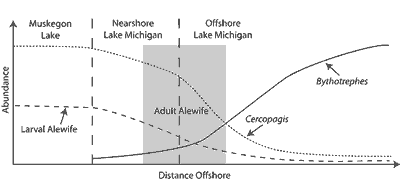
Fig. 3. The hypothesized conceptual spatial relationships among alewives, Cercopagis, and Bythotrephes in Muskegon Lake and Lake Michigan. Larval alewives compete with Cercopagis in the warm waters of Muskegon Lake and nearshore Lake Michigan. Bythotrephes controls Cercopagis abundance in deep waters and adult alewife predation keeps Bythotrephes in check in nearshore and mid-depth waters.
Whether Cercopagis, Bythotrephes, or their prey is seriously depleted by predation depends on predation rate relative to birth rate. Birth rate is affected by food quantity and quality (bottom up effects). We can use the egg-ratio method to estimate population growth rates and to identify areas of high population growth (Muskegon Lake vs. Lake Michigan) for Cercopagis, Bythotrephes, and other cladocerans (the prey). These estimates of population growth can be compared to estimates of mortality imposed by Cercopagis, Bythotrephes, and alewives to determine significance of mortality imposed by predation.
In 2002, the larval fish team finished zooplankton and larval fish sampling in Muskegon Lake and Lake Michigan to determine the spatial distribution, abundance and diet of first year alewife. The two teams in 2002 and 2003, collaborated to explore simultaneous towing the plankton survey system (PSS, e.g. Fig. 4) and 120 KHz split beam acoustic fish to determine vertical distributions of physical variables, chlorophyll fluorescence, zooplankton and larval, juvenile, and adult alewives along a transect through Muskegon Lake to offshore Lake Michigan. Vertical profiles of chlorophyll and nutrients were determined at all master stations, and coarse vertical profiles (epi-, meta-, hypolimnion) of zooplankton determined by use of a vertical net with choke off were determined in late summer at M45. The standard limnological variables were successfully collected; however, there were problems in the collection of the acoustic data in both 2002 and 2003.
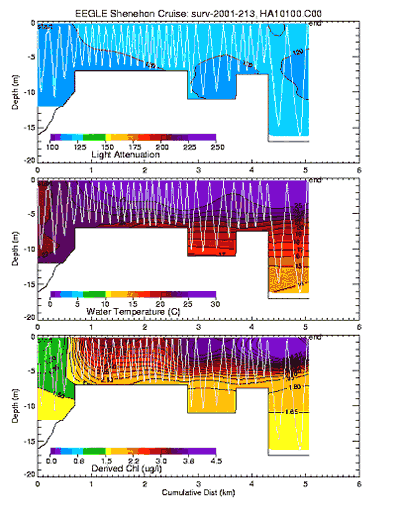
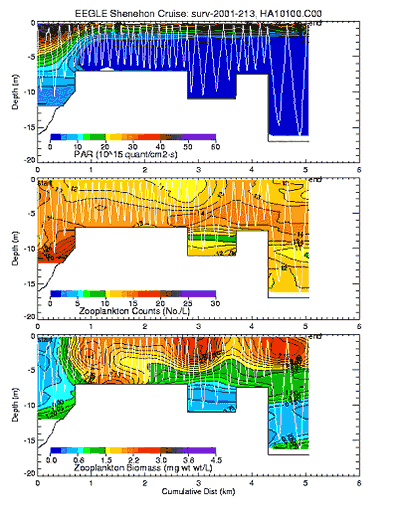
Figure 4. Plankton survey system (PSS) transect from Lake Michigan just outside of the Muskegon River mouth (left) through the shipping channel of Muskegon L. to its deepest point. Note that the waters of Muskegon Lake are warmer and richer in plankton than Lake Michigan.
Program Accomplishments
- We have been doing data analyses of experiments that were performed in 2002 and 2004 that were designed to determine prey selection by Bythotrephes and Cercopagis on a variety of zooplankton prey found in Lake Michigan as well as the possible role of Bythotrephes predation on Cercopagis in limiting Cercopagis distribution in Lake Michigan.
- We reexamined available alewife selectivity data to compare selection of alewives for both Bythotrephes and Cercopagis, and we presented evidence that fish predation regulated establishment of Bythotrephes and Cercopagis in the Great Lakes.
- We are analyzing results of an intense field experiment carried in August 2004 to evaluate time varying spatial coupling and predatory interactions among fish (primarily alewives), Bythotrephes, Cercopagis, and other zooplankton over the diel cycle.
- We did intense diel of sampling (every four hours) of: zooplankton distribution by net tows, pumping, and plankton survey system; fish distribution by acoustics; and fish in trawls for diet analyses at a deep (60 m) and shallow (10 m) stations near Muskegon, Michigan, during the time period of the full moon and the new moon to determine spatial and predatory interactions among Bythotrephes, Cercopagis, alewives, and zooplankton under different light conditions in August. Preliminary analyses of the data showed that thermal structure strongly regulated zooplankton distribution and that alewives fed throughout the day and night and fed heavily on Bythotrephes during parts of the diel cycle and that Cercopagis was rarely eaten. We expect that when zooplankton sample analyses are complete that this will be a clear demonstration that Bythotrephes is strongly preferred over Cercopagis. These results are extremely important for understanding fish/cercopagid interactions because there has been doubt expressed by other researchers (reviewers of one of our manuscripts) that this preference is possible.
- We continue to examine a new hypothesis to explain the disappearance of two out three species of Daphnia when Bythotrephes invaded Lake Michigan. This hypothesis argues that escape reactions of these species determines their vulnerability to predation by Bythotrephes.
2005 Research Progress
Objective: Determine prey selection and consumption by Cercopagis and Bythotrephes for major crustacean zooplankton taxa, rotifers, and Dreissena in Lake Michigan and other Great Lakes using traditional bottle or enclosure experiments and video observations of predation mechanisms.
We continued to examine prey selection by all instars of Bythotrephes and Cercopagis to determine their feeding rates and prey selection with focus of determining predation and prey selection at low concentrations of prey and carefully examining selection in multi-species prey assemblages. We explored the possibility that two of three species of Daphnia that disappeared from the Great Lakes when Bythotrephes invaded did so because they had weak escape response from Bythotrephes attacks. This was done by examining Bythotrephes predation for these species offered together in bottles and prey escape response observed directly in the cinematography lab. All samples from experiments were processed and data summarized and partly analyzed. The analysis of videotapes on prey escape response at Bythotrephes presence is close to completion.
Objective: Examine impact of Cercopagis and Bythotrephes on nearshore prey field in Lake Michigan utilized by larval and YOY fishes and evaluate consequences to fishes.
We made much progress on determining population dynamics of Bythotrephes, Cercopagis, Leptodora (a spineless native predatory cladoceran) and their zooplankton prey from net tow collections made in 2000-2003-All zooplankton from Stations M15, M45, and M110 have been counted and their biomass determined for 153 µm net collections. We determined that Bythotrephes predation on Cercopagis probably controls spatial distribution of Cercopagis. We need now to compare prey consumption of the cercopagids with that of alewives and determine impacts to the zooplankton community and alewives.
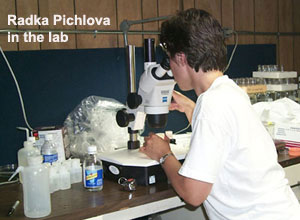
Objective: To evaluate the impact of yearling and adult alewife predation on Bythotrephes and Cercopagis, we need information on zooplankton abundance and vertical distribution (including the cercopagids), alewife abundance, distribution, food habits, and food consumption during both night and day.
We reexamined alewife diet and selectivity data on Cercopagis not reported in the Vanderploeg and Pothoven (2004) paper to compare selection of alewives for both Bythotrephes and Cercopagis, and we presented evidence that fish predation regulated establishment of Bythotrephes and Cercopagis in the Great Lakes. We determined that the strong preference of fish (alewives) for Bythotrephes over Cercopagis might allow Cercopagis to exist in Great Lakes where fish control Bythotrephes abundance. We worked with USGS Great Lakes Science Center personnel to examine this hypothesis in greater detail. A corollary hypothesis is that fish predation pushes the size of zooplankton downward favoring the smaller predator, Cercopagis. A manuscript was submitted on this subject but rejected. Part of the problem reflected a reviewer's skepticism over our rarely finding Cercopagis in the stomach contents of the fish.
We made progress in analyzing results of the intense diel sampling (every four hours) cruises of August 2004 that measured: zooplankton distribution by net tows, pumping, and plankton survey system (PSS); fish distribution by acoustics; and fish in trawls for diet analyses at a deep (60 m) and shallow (10 m) stations near Muskegon, Michigan, during the time period of the full moon and the new moon to determine spatial and predatory interactions among Bythotrephes, Cercopagis, alewives, and zooplankton under different light conditions.
On both full moon and new moon cruises we obtained both cross-isobath (M10-M110) simultaneous acoustic and PSS transects during day and night that will allow us to examine spatial distribution of fish and total zooplankton biomass. At M10 and M60 we did simultaneous PSS and acoustics runs on ~ 4 h intervals and did opening/closing net sampling in epi-, meta-, and hypolimnion, and pumping for zooplankton at multiple depths (6 depths at M60 and 2 at M10) to get fine scale vertical distribution of different zooplankton species.
Alewife were unusually concentrated in the nearshore area and few fish were caught in the offshore area. However, alewife were collected every four hours in the nearshore area during both trips and we were able to quantify diets and daily ration for adult and yearling alewives. A total of 653 alewives were examined for diet analysis and daily ration calculations. All laboratory work on alewives was completed. Both Bythotrephes and Cercopagis were present during at least some of the sampling times for each date. The fish and zooplankton data that were collected will be adequate to quantify the role alewife planktivory plays in structuring Bythotrephes and Cercopagis populations in nearshore areas. We had anticipated sampling in a transitional area (45 m), but large quantities of dreissenid mussels in the area prevented effective sampling of fish. Most planktivorous fish in the nearshore were alewife, but spottail shiners Notropis hudsonius were also abundant at night. Other species will be examined if deemed necessary. We have completed counting most of the zooplankton samples (~80%) for this intensive study. Diet selectivity will be calculated once zooplankton counts are finished.
Much of the work on spatial distribution of zooplankton and alewives using PSS and acoustics has been completed. Fine tuning of the optical plankton counter (OPC) results by calibration of a laboratory OPC system are necessary to complete the analysis so we can assign size ranges to Daphnia and Bythotrephes, the major zooplankton of interest in the study. Also, the net tow data have to be correlated with OPC counts. The results (some of which are shown in Figures 4b and 4c) show that zooplankton, particularly large zooplankton like Daphnia are concentrated in narrow bands during the day and that the depth of the bands varied greatly between cruises, a likely result of the thermal structure. This change in vertical distribution influenced the overlap between fish and zooplankton.
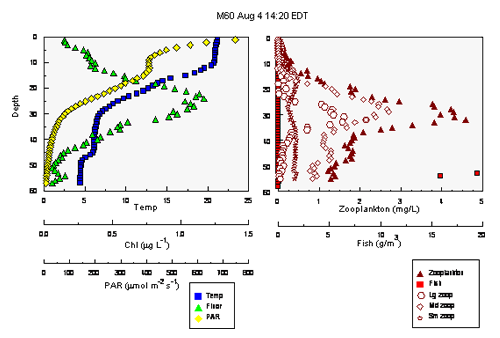
Figure 4b. Depth distribution of temperature, chlorophyll, and light, zooplankton and fish determined with PSS and acoustics early afternoon on August 4, 2004.

Figure 4c. Depth distribution of temperature, chlorophyll, and light, zooplankton and fish determined with PSS and acoustics early afternoon on August 18, 2004.
Prior Data Highlights
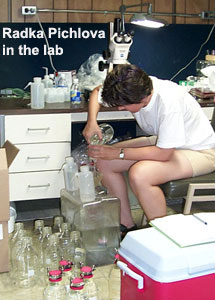 Experimental
work on feeding- In the 2002 field season work continued to focus
on selection of different species and size s of prey in bottles. Altogether
24 experiments with 5, 10 or 20 items of various common potential prey
species (Bosmina longirostris, Asplanchna, nauplii, diaptomids,
cyclopoids, Conochilus, zebra mussel larvae and brine shrimp larvae)
of different sizes were run. The Bosmina used in experiments came
from cultures maintained in the lab started from individuals isolated
from Lake Michigan. All other prey were isolated from Lake Michigan at
the time of the experiment. Also, we tested some combinations of two prey
species to look at possible Cercopagis selection between them.
Additionally, one experiment with natural zooplankton assemblage in natural
concentration and twice more dense to natural concentration was performed
in big bottles put into a big deck top incubator. Most of the prey preserved
from these experiments need to be counted (and sized). Resting eggs were
collected at the time animals collected for feeding experiments so that
we have a supply for observation of hatching and feeding behavior during
this winter.
Experimental
work on feeding- In the 2002 field season work continued to focus
on selection of different species and size s of prey in bottles. Altogether
24 experiments with 5, 10 or 20 items of various common potential prey
species (Bosmina longirostris, Asplanchna, nauplii, diaptomids,
cyclopoids, Conochilus, zebra mussel larvae and brine shrimp larvae)
of different sizes were run. The Bosmina used in experiments came
from cultures maintained in the lab started from individuals isolated
from Lake Michigan. All other prey were isolated from Lake Michigan at
the time of the experiment. Also, we tested some combinations of two prey
species to look at possible Cercopagis selection between them.
Additionally, one experiment with natural zooplankton assemblage in natural
concentration and twice more dense to natural concentration was performed
in big bottles put into a big deck top incubator. Most of the prey preserved
from these experiments need to be counted (and sized). Resting eggs were
collected at the time animals collected for feeding experiments so that
we have a supply for observation of hatching and feeding behavior during
this winter.
"Monitoring" and population studies- Zooplankton net tows, nutrients, chlorophylls, were collected as planned. Zooplankton samples were collected as duplicate vertical tows from bottom to surface and nutrients and chlorophylls were sampled in the epilimnion, metalimnion and hypolimnion on indicated dates. Also, vertical structure (epi-, meta-, hypolimnion) of zooplankton was determined for day and night during one day and night. Zooplankton samples have not been counted.
During summer season our CILER intern Lenka Stara finished counting and measuring of Cercopagis, Bythotrephes and Leptodora in 2000 and 2001 samples.
Conclusions
- Total abundance of Cercopagis, Bythotrephes and Leptodora were significantly lower in 2001 than in 2000 at all stations (See Figures 5-7 below)
- The summer population of Cercopagis females have higher average number of eggs than embryos in the brood pouch, which implies possible resorption of eggs during maturation and therefore possible food limitation
- The spine/body ratio was lower in 2001 in Cercopagis than in 2000, whereas in Bythotrephes it increased (See Figures 8-9)
- Cercopagis dominates in the inshore and Bythotrephes dominates in the offshore.
- Leptodora, contrary others' claims is still an important member of the predatory cladoceran group.

Figure 5: Seasonal dynamics of abundance of Bythotrephes cederstroemi, Cercopagis pengoi and Leptodor kindtii in Lake Michigan at the M-15 station (nearshore) in 2000 and 2001.
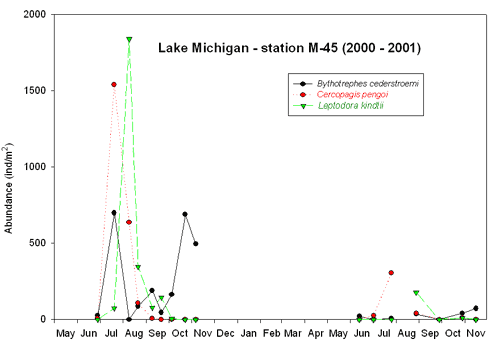
Figure 6: Seasonal dynamics of abundances of Bythotrephes cederstroemi, Cercopagis pengoi and Leptodor kindtii in Lake Michigan at the M-45 station (mid-depth) in 2000 and 2001.
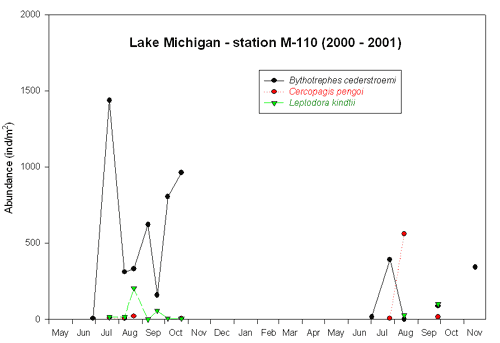
Figure 7: Seasonal dynamics of abundances of Bythotrephes cederstroemi, Cercopagis pengoi and Leptodor kindtii in Lake Michigan at the M-110 station (offshore) in 2000 and 2001.
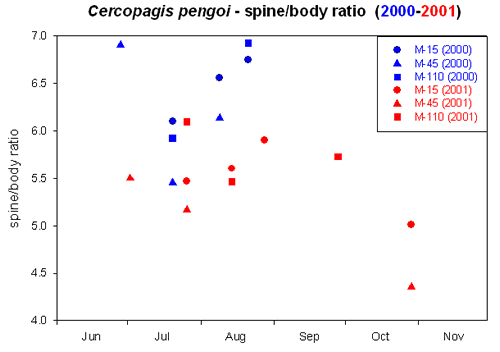
Figure 8: The spine/body ratio of Cercopagis pengoi in Lake Michigan. The ratio of 2000 (blue) as well as the year 2001 (red) are divided into 3 categories: samples from the M-15 station (circles), samples from the M-45 station (triangles), samples from the M-110 station (squares).
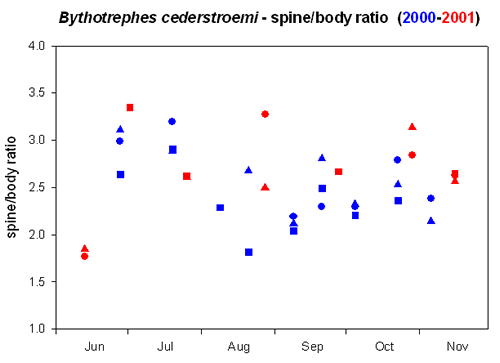
Figure 9: Spine/body ratio of Bythotrephes cederstroemi in Lake Michigan. The ratio of year 2000 (blue) as well as of the year 2001 (red) are divided into 3 categories: samples from the M-15 station (circles), samples from the M-45 station (triangles), samples from the M-110 station (squares).
Publications
Bundy, M.H. and Vanderploeg, H.A. 2002. Detection and capture of inert particles by calanoid copepods: the role of the feeding current. J. Plankton Res. 24: 215-223.
Madenjian, C.P., G.L. Fahnenstiel, T.H. Johengen, T.F. Nalepa, H.A. Vanderploeg, G.W. Fleischer, P.J. Schneeberger, D.M. Benjamin, E.B. Smith, J.R. Bence, E.S. Rutherford, D.S. Lavis, D.M. Robertson, D.J. Jude, and M.P. Ebener. 2002. Dynamics of the Lake Michigan food web, 1970-2000. Can. J. Fish. Aquat. Sci. 59: 736-753.
Pothoven, S.A., G.L. Fahnenstiel, and H.A. Vanderploeg. 2001. Population dynamics of Bythotrephes cederstroemii in southeast Lake Michigan 1995-1998. Freshwater Biology 46: 1491-1502.
Vanderploeg, H.A., T.F. Nalepa, D.J. Jude, E.L. Mills, K.T. Holeck, J.R. Liebig, I.A. Grigorovich, and H. Ojaveer. 2002. Dispersal and ecological impacts of Ponto-Caspian species in the Great Lakes. Can. J. Fish. Aquat. Sci. 59: 1209-1228.
Last updated: 2006-02-17 mbl

